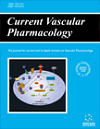-
oa Editorial [Hot topic:Vascular Protective Effects of Ezetimibe: Seeking New Therapeutic Possibilities of Ezetimibe in Vascular Disease (Guest Editor: Minako Yamaoka-Tojo)]
- Source: Current Vascular Pharmacology, Volume 9, Issue 1, Jan 2011, p. 61 - 61
-
- 01 Jan 2011
Abstract
Atherosclerosis is known to increase the prevalence of metabolic disorders such as dyslipidemia, diabetes, and metabolic syndrome. Dyslipidemia, especially elevated levels of low-density lipoprotein (LDL)-cholesterol, is central to the management of patients at risk of atherosclerosis [1]. Traditional LDL-cholesterol lowering-therapy has focused on modifying the endogenous lipid pathway using HMG-CoA (3-hydroxy-3-methylglutaryl coenzyme A) reductase inhibitors, statins. Intensive LDLcholesterol reduction with statins is associated with improved clinical outcomes in the setting of coronary artery disease [2-4], but is sometimes associated with an increased incidence of adverse drug reactions when traditional agents are used [5]. Ezetimibe (Zetia®), is a comparatively new discovered selective inhibitor of cholesterol absorption, has proved to be highly effective in lowering LDL-cholesterol with both monotherapy and combination therapy with statins [6]. Ezetimibe is expected to be the best pharmacological option for the treatment of patients unable to achieve ideal LDL-cholesterol goals with statins [7]. In recent studies, ezetimibe improved not only lipoprotein profiles but also metabolic disorder and fatty liver disease by suppressing intestinal chylomicrons production in patients with hypercholesterolemia [8, 9]. Although much evidence has revealed preventive effects of ezetimibe on atherosclerosis in several animal models, there is currently little evidence proving that treatment with ezetimibe is effective against cardiovascular events or death in humans; therefore, choosing ezetimibe to lower LDL-cholesterol is currently controversial [5]. This special issue of Current Vascular Pharmacology (CVP) is dedicated to vascular protective effects of ezetimibe focused on the recent findings of ezetimibe in vascular system. Moreover, known and proposed mechanisms of how ezetimibe may improve various vascular functions are discussed; these effects may be helpful to explain the mechanisms by which ezetimibe may protect vascular from atherosclerosis. The purpose of this special issue of CVP is to remind readers of the evidence-based therapeutic possibility of ezetimibe and of its clinical relevance. Reviews have been written by forefront experts on data obtained from experimental animal models and/or clinical studies. A variety of excited topics are covered including ezetimibe: an update after 4 years (Chapter 1), effects of ezetimibe on: vascular endothelial function (Chapter 2), vascular inflammation from the view of immune response (Chapter 3), reactive oxygen species (Chapter 4), hepatic metabolism (Chapter 5), and vascular calcification and metabolism (Chapter 6). We hope this special issue will help investigators in the field of prevention for cardiovascular disease and atherosclerosis to understand recent ezetimibe-related studies and find new aspects.


